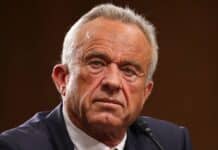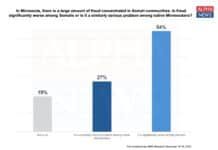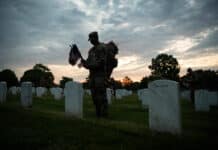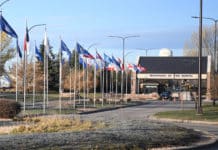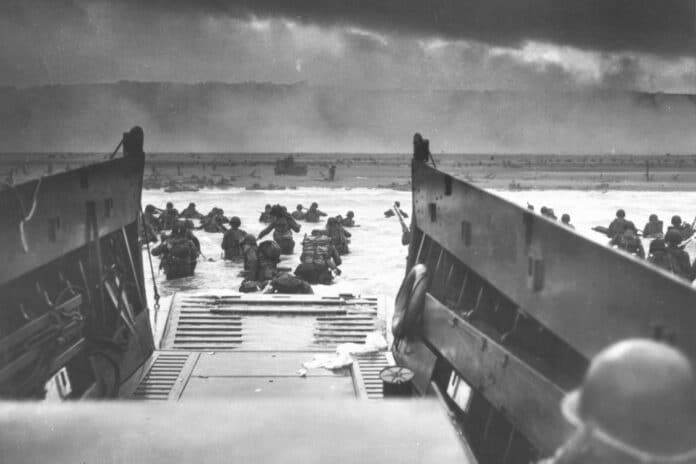
(American Greatness) — Eighty years ago this morning, 156,000 members of the armies of the United States, the British Commonwealth, and the forces of the occupied countries of Europe stormed the beaches of Normandy in the greatest single-day invasion in human history. Less than a year later, on May 8, 1945, the war in Europe ended with Germany’s capitulation.
When the invading forces hit the Normandy beaches and paratroopers landed behind the lines, the success of the invasion was not a sure thing. Despite years-long planning, so much could still go wrong. Supreme Allied Commander Dwight D. Eisenhower and his staff believed that invasion-day casualties could reach more than 50%. Ike was so concerned that he penned an address if the invading forces had to be withdrawn. Thankfully, even though casualties were heavy, they were far less than the worst-case scenarios.
For me, the day has always fascinated me. It goes back to 1962, when I was just eight years old, watching the feature film The Longest Day (viewable for free on YouTube). With its star-studded cast that included John Wayne, Kenneth More, Richard Todd (who participated in the landings), Robert Mitchum, Richard Burton, Sean Connery, Henry Fonda, Gert Fröbe, Curd Jürgens, Robert Wagner, and dozens more. It was shot in black and white and was released just 18 years after the invasion itself. It had an almost documentary quality, showing the day from both sides — the Allies as well as the Germans.
Fast forward to 2001. I was in Europe covering the 2001 Frankfurt Auto Show on September 10 and 11. Frankfurt was a huge show, spread among seven separate exhibition halls. My work on Day 2 was done by 2 p.m. local time and I started walking the floor to get some additional photos after the press conferences had concluded.
After grabbing some photos of one of the concept car reveals I missed earlier, I walked the floor and went past a BMW SUV on display that had several small screens installed externally, surrounded by a group of journalists. I thought nothing of it at the time until a colleague said to me, “Did you hear what happened in New York City? An airliner just crashed into one of the World Trade Center towers.”
It immediately dawned on me, that explained the crowd around the BMW. I walked back to the BMW and, at 3:03 p.m. local time, watched in horror as the second plane hit the south tower. I’m sure I’m not alone in remembering exactly where I was at that moment, similar to those old enough to remember where they were when JFK was assassinated in 1963, Nixon’s resignation in 1974, or when the Challenger space shuttle exploded in 1986.
If you remember that day, after the attack on the Pentagon and the fourth crash in Pennsylvania, you know that all air traffic was shut down to and from the United States. At that point, I had no idea how or when I would return to the United States but I suspected it would be several days.
I called the local DaimlerChrysler press fleet manager and asked if I could extend the loan on the Jeep Wrangler I was driving and was told there was no problem. Upon returning to my room that night, I drew up a plan — a plan that would take me more than 500 miles west to Normandy. I was going to cross off a bucket list item to visit the Normandy beaches, then drive west over the Road to Liberty to Bastogne, Belgium.
The next morning, I set out for Normandy and arrived in Caen on the evening of September 12. Along the way, I picked up historic Michelin maps of the Normandy battlefield as well as the Road to Liberty itself. The following morning, not long after sunrise, I found myself on Omaha Beach. Driving up on the sandy beach in my Wrangler, I looked out over the English Channel. It wasn’t too difficult to imagine some 18-year-old German soldier looking out as the landing barges hit the beach.
In the aftermath of the confusion surrounding the 9/11 attacks, I knew life would never be as it was. How true that turned out to be!
The towns along the coast are dotted with monuments and historic sites too numerous to mention here. For that, I invite you to read my two-part travelogue that was published in 2002 in Four Wheeler magazine. I document how I spent the following three days following in the tank tracks of General Patton’s Third Army as he dashed across France in the summer of 1944.
In 2004, I returned to Normandy to celebrate the 60th anniversary of D-Day. Everywhere I went, I was able to talk to many veterans of that day. It was such an honor to speak to and interview them as they recalled the most important day of their lives. For most, it was the day that defined them. The youngest of the veterans were then in their late seventies or older. I have to admit, being 50 at the time, I was in absolute awe of them.
Five years ago, I had hoped to return, having missed the 70th anniversary. I planned to host a group of World War II enthusiasts on an escorted tour of the Normandy beaches and, together, in Jeeps, of course, duplicate my 2001 drive from Normandy to Bastogne. But things never fell into place as I had hoped. To this day, I look back and see it as a lost opportunity.
Today, the 80th anniversary of the greatest seaborne invasion in human history, is an opportunity to pause and express our admiration for our fathers, grandfathers, uncles, and, in some cases, great-grandfathers who stormed the white sandy beaches of Normandy that June morning in 1944, when the few survivors who remain return one final time, commemorating the most important day of their young lives. In these divided and highly partisan times, can we all pause for a few minutes to say thanks and honor the sacrifice of what truly was America’s Greatest Generation?
I know I will.
This article was originally published at American Greatness.
Richard Truesdell
Contributor Richard Truesdell is an automotive and travel photojournalist. In the last 25 years has visited more than 35 countries on six continents. A former high school history teacher with a BA in Political Science from Waynesburg University, he is a lifelong Conservative moderate who has turned his thoughts and keyboard to political commentary and popular culture.



